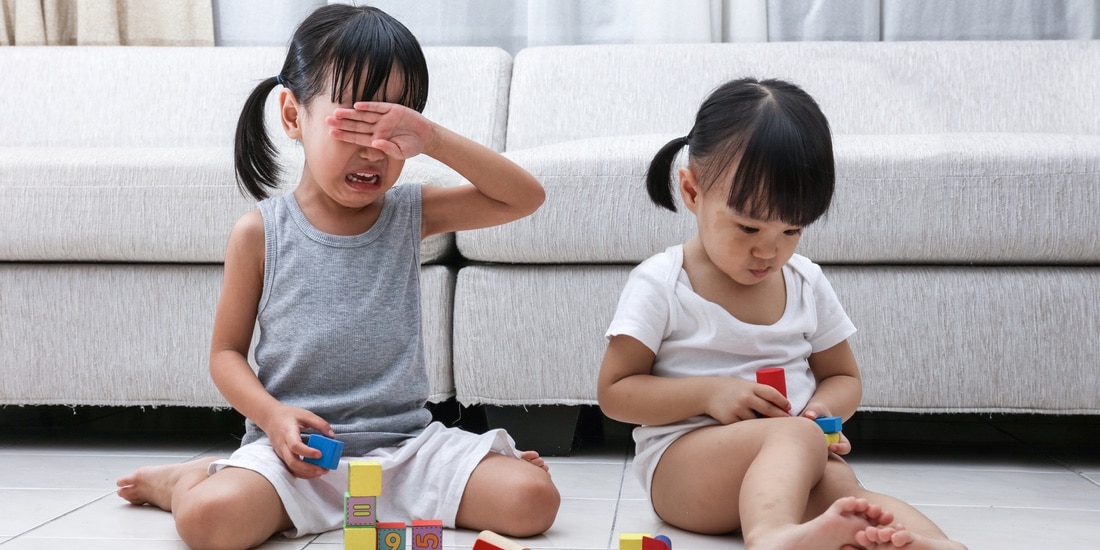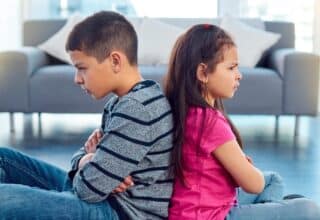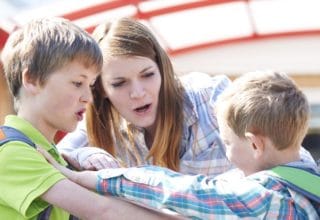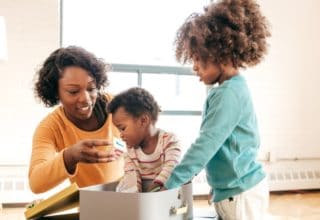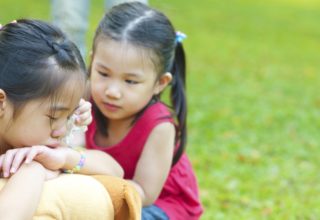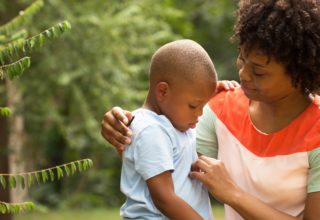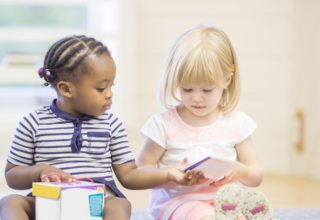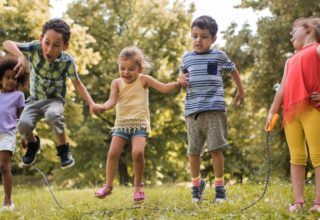Sibling fighting and rivalry is normal and, in most cases, healthy. Learn how to resolve sibling conflict in 5 simple steps. (But in the heat of the moment.)
-Pamela Dugdale
Learn
Basic Concepts
- Parents, ultimately, have little control over sibling relationships, especially as children grow into adulthood. Whether you consider that thought freeing or frightening, recognize that despite not being able to dictate the outcome, you can, however, control how you teach your children to interact with each other as they build and strengthen their relationship.
- A study from the University of Illinois found that it is the amount of positive interactions siblings experience which determines the quality of their relationship – regardless of the number of fights they have.
- Focus most on the relationship you want your children to have with each other now and as adults, and be intentional in helping to foster that positive, supportive bond.
- You need to be intentional in teaching your children how to interact with one another. Sibling relationships and friendships are often complex; we cannot expect young children to figure out how to navigate these confusing relationships on their own.
- When siblings fight, they learn important life skills that are learned skills: how to advocate for themselves, negotiate, compromise, creatively problem-solve, perspective-taking, have empathy, identify feelings and emotions, calm themselves down, active listening, etc.
- Sibling fights are often a child’s first opportunity to develop and practice conflict resolution skills.
- As you help your children navigate their struggles, think of yourself as a coach or facilitator rather than a judge and jury. You are on ‘Team Sibling Relationship’ and should remain neutral and avoid taking sides. Step in to ensure physical and emotional safety, but try not to solve their problems for them.
- Your job is to help your children learn to cope and independently solve their conflicts. Encourage your children to independently problem-solve using the Wheel of Choices before coming to you.
- We can help calm our children by calming ourselves because their interbrains are wired to mimic the interbrains around them. Interbrains are the various components of our brain that work together to act as a relay center for visual, auditory, and motor system information. Read more groundbreaking research to understand your child’s emotions and behaviors.
Just Remember
- Siblings fight. It is normal and healthy. Its evolutionary basis in survival means that parents should expect the fights and view them as typical, even if triggering.
- Learning how to resolve sibling conflict is a valuable skill that can translate to other relationships. We can influence this learning by teaching our children how to interact with each other.
- Remain neutral, avoid taking sides and try not to solve their problems for them. But step in to ensure physical and emotional safety.
Do
5 Steps to Handling Sibling Fights
Let your children try to solve their problems first (even if someone is crying). But step in to ensure physical and emotional safety when needed. When you do need to step in, here are 5 steps to remember:
- Stay calm. Get everyone grounded – recalibrated. Grown-up takes a deep breath and counts to five – backwards (even better if the kids can see this).
- Respond to hurt child without blaming aggressor.
- *State the rule.* This is about the rule, not the grown-up’s reaction to the incident.
- Model calming behavior. Deep breaths, speak slowly, use fewer words.
- Process the fight: talk and listen, find a solution, make a plan.
Our 5 Steps – In Practice
Below is a sample scenario with step-by-step directions for a suggested approach. (But if you only have a minute.)
Quinn (age 6) is in the family room playing with the pirate ship he recently received as a birthday present when his sister, Kira (age 4) comes into the room.
“I want to play with you,” she says.
“No,” says Quinn, “I want to play alone.”
Kira lingers for a few minutes and then grabs a pirate figurine off the ship. Quinn stands up and grabs for the pirate and when Kira holds it out of reach, he pushes her and she falls down hard.
She starts crying and both kids start yelling for mom, who is busy doing something pressing.
- Stay calm.
- Mom takes a deep breath and counts to five – backwards.
- She recognizes that although there has been aggression, there isn’t an immediate risk of another physical outburst.
- Taking this breath gives her the time to think briefly about her response and, if the kids can see, is great modeling of a useful tool to calm rising emotions.
- Mom also gets everyone grounded – recalibrated. Without the grounding or recalibration, the core behavior may not be able to be addressed.
- Mom gives one child a sensory toy and crouches down to the other child’s eye level, putting her hands gently on their shoulders, and takes deep breaths together.
- Respond to hurt child without blaming aggressor.
- Say what you see to avoid getting emotional.
- It’ll show that you’re neutral, not taking sides and not making assumptions.
- Example:
- Mom says, “Wow! It sounds like you both are really upset. Kira, are you hurt?”
- Kira says, “He pushed me and I fell down and hurt my side!” with a new round of wails.
- Mom says, “Ouch! Quinn hurt your body and you’re angry. Let me rub it for you and see if that helps.” If a child is truly hurt, it’s important to address it, but do so without blaming the other child.
- Say what you see to avoid getting emotional.
- *State the rule.* Be concrete.
- This is about the rule, not the grown-up’s reaction to the incident.
- Reminding children of guidelines, rules or limits helps ground the subsequent discussion and keeps it neutral.
- Example:
- “In our family, we treat each other kindly and respectfully and do not use our words and bodies to hurt each other.”
- “You can say ‘excuse me’ if someone is in your way. We do not push.”
- Model calming behavior.
- Encourage both kids to take three “flower breaths” as if inhaling a flower and then to “blow out a candle” exhaling deeply. Before both children share what happened, it’s important to make sure everyone is calm.
- If the kids refuse to breathe, it may be time for everyone to separate for a few minutes to make sure everyone is calm before processing the conflict.
- If the kids refuse to separate, physically place yourself between them (so it is a signal to them that you’re keeping everyone safe) and elaborately model deep breathing, and say, “Ok – Time out, freeze! We’re going to count backwards first. Do it with me: 10-9-8…”
- Process the fight: talk and listen, find a solution, make a plan.
- Ask each child to take a turn to share their perspective on the conflict.
- Ask many questions of the kids, teaching empathy and perspective-taking.
- Actively listen to each child and help them to do the same.
- Coach them to express their feelings and to state their needs using “I” messages.
- Facilitate finding a resolution that will work for both children. Try not to solve their problems for them.
- And, when appropriate, help them make a plan for the next time this type of conflict may arise.
All of this takes a lot of time and energy, and it is hard work. But coaching your children in this way increases the chances that they develop skills to handle conflict themselves. As siblings learn how to have a relationship with one another, how to settle inevitable conflicts and interact in ways that respect your family guidelines, your job will become easier. Take the long view and consider your energy an investment in their future sibling relationship.

Paige Abramson Hirsch, Teacher + Education Consultant + Parent
Paige Abramson Hirsch is an elementary school teacher turned lawyer turned educational administrator and educational consultant supporting school districts and charter schools. Paige studied psychology with a focus in child development at Tufts University and holds a JD/M.Ed from the University of Minnesota. Paige previously served on the Board of HAND, a non-profit for bereaved parents. She lives in San Carlos, California with her husband and two young children, whom she thanks for providing her with endless opportunities to analyze child development and behavior!
Sibling rivalry and fighting are normal parts of family dynamics, but they can really disrupt a home’s harmony and stir...
Should parents force siblings to ‘get along’? What do you say when siblings are constantly competing with each other? What...
Get flustered in the heat of the moment when your children fight? Use these three key phrases to stop sibling...
We can’t end sibling fighting nor force our children to get along, but we can help them recall happy moments...
Siblings fight – it is normal and expected, and you can handle it. But sometimes, stepping outside of the normal...
Empower your child to manage their emotions and regain control in heated situations with *STOP!*
A breathing exercise to help your child move through the rocky moments in their day. Easy to do and remember....
Help your child learn how to resolve a social conflict on their own with this framework – Wheel of Choices.
Empower your child with a valuable life skill – teach them how to express their emotions and desires during conflict.
Learn why it is important for your child to be able to identify their emotions, and help them build their...
Teach your child to *THINK* before they speak – to consider the impact of their words (vs. their intent). A helpful...
It may feel like a number of impulsive behaviors are seemingly normal for children. But what is ‘normal’? In this...
Acknowledge and promote positive behavior….*Plinkit* with a Marble Jar! You’ll be amazed at the twinkle in your child’s eye each...
A simple tip sheet for how to praise your child. Something more than “Good job” or just commenting on process and...
Social exclusion is a main theme in a child’s development and there are many reasons why it happens. Empower your child to...
“Empathy is when you’re able to understand and care about how someone else is feeling.” -Mark Ruffalo, Sesame Street
A classroom favorite for cultivating empathy, kindness, community membership and awareness of others. What’s a real superhero? Someone who helps...
“The way we talk to children becomes their inner voice.” -Peggy O’Mara
Conflict is natural for preschoolers who are just learning about peers and group settings – it is expected, healthy and...
Around the ages of four and five, children begin to tell ‘tall tales’. They may also begin to tell fibs...
Tattling is very common but it can be shaped by our responses to their tattling. Teach your child this simple rhyme to work...
While some children inherently understand how to socially interact with others and are comfortable with basic social skills, others need more...
